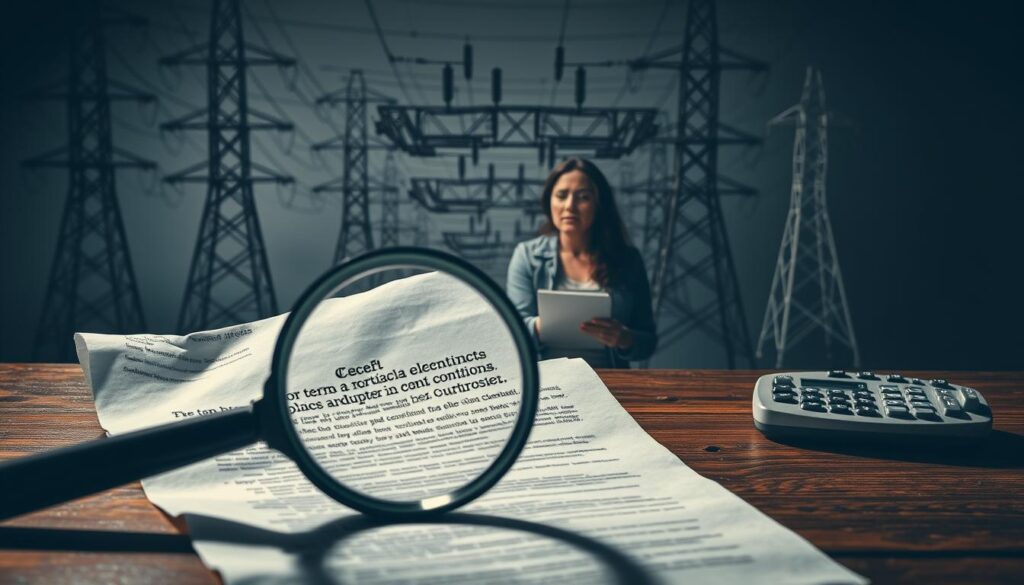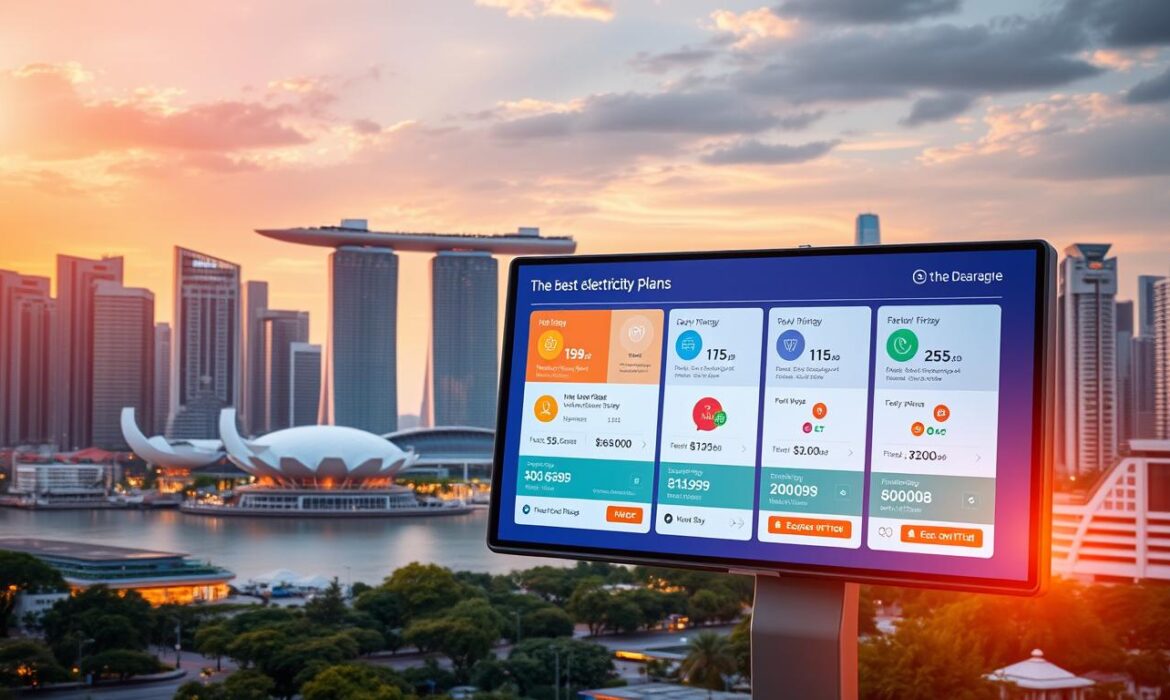Singapore’s energy market offers plenty of choices since its deregulation. Households now have the power to pick providers that match their needs. Comparing options helps you save money while getting reliable service.
Rates, contract lengths, and special deals vary between retailers. The current SP tariff stands at 30.65¢/kWh, including GST. By switching smartly, families can cut monthly bills by 5% to 20%.
This guide walks you through 16 key topics—from pricing trends to eco-friendly choices. Whether you’re moving or just optimizing costs, we’ll help you decide wisely.
Key Takeaways
- Singapore’s open market lets consumers choose their preferred provider.
- Comparing rates and promotions can lead to significant savings.
- The current benchmark tariff is 30.65¢/kWh (including GST).
- Switching retailers may reduce monthly expenses by 5-20%.
- This guide covers tariffs, green options, and practical tools.
Introduction to Singapore’s Open Electricity Market (OEM)
Singapore transformed its power sector in 2018 by introducing consumer choice through the Open Electricity Market. The Energy Market Authority (EMA) phased this initiative from November 2018 to May 2019, replacing the old monopoly system with competitive pricing from six retailers.
What Is the Open Electricity Market?
The OEM lets households and businesses buy power from licensed retailers like Geneco or PacificLight. SP Group still manages the grid, but providers now compete on rates and perks. This shift mirrors global trends toward liberalized energy markets.
How Does the OEM Benefit Consumers?
Shoppers save by comparing fixed-rate or discount plans against SP’s regulated tariff. Switching is seamless—no service disruption occurs. Retailers also offer green energy options and referral rewards, adding value beyond cost savings.
- Price transparency: Easily compare rates online.
- Flexibility: Choose contracts from 6 to 36 months.
- Innovation: Some plans include smart home perks.
Understanding Electricity Tariffs in Singapore (2025)
Tariff structures directly impact what you pay for power each month. In 2025, the regulated tariff remains a benchmark, with Q1 rates at 30.65¢/kWh (including 9% GST). This reflects a base cost of 28.12¢/kWh before taxes.
Current Electricity Tariff Rates
SP Group’s rate covers three main components:
- Energy costs (74.3%): Fuel prices drive this 21.36¢/kWh segment.
- Network fees (22.5%): Grid maintenance adds 6.46¢/kWh.
- Market operations (3.2%): Includes admin and support fees.
For context, a 4-room HDB averages $111.87/month under SP’s standard rate. Retailers often undercut this—compare retailer rates to save more.
How Tariffs Are Calculated
Quarterly adjustments track global oil and gas markets. When fuel prices rise, the electricity tariff follows. For example, a 10% spike in energy costs could add ~2.1¢/kWh to bills.
Network fees stay steadier, tied to local infrastructure upgrades. These fees ensure reliable delivery, even during peak demand.
Types of Electricity Price Plans Available
Three main pricing models dominate Singapore’s competitive energy market. Each offers unique advantages depending on your budget and risk tolerance. Understanding these price plans helps maximize savings while meeting household needs.
Fixed Price Plans
Fixed price contracts lock in rates for 6-36 months, shielding you from tariff hikes. Geneco’s 24-month option at 28.87¢/kWh beats SP’s current 30.65¢ rate. This stability makes them ideal for:
- Households with predictable usage
- Budget-conscious consumers
- Those avoiding market volatility
Discount Off Regulated Tariff (DORT) Plans
These discount regulated plans offer percentages off the quarterly SP tariff. PacificLight’s Classic 60 gives 3% savings plus 5% extra for prompt payments. Benefits include:
- Automatic savings when tariffs rise
- Bonus rebates in some packages
- Long-term security (up to 60 months)
Wholesale Electricity Plans
Wholesale electricity prices change hourly based on market demand—from 0.069¢ to 4.42¢/kWh in past cycles. While potentially cheaper, they require:
- Active usage monitoring
- Flexibility to shift high-consumption activities
- Risk tolerance for price spikes
Some retailers like PacificLight blend models with time-based discounts (e.g., night rates). Compare all options to find your ideal electricity price structure.
Comparing the Best Electricity Retailers in Singapore
With multiple retailers competing in Singapore’s market, finding value requires careful comparison. Each provider offers distinct rates, contract terms, and promotions tailored to different needs. Below, we break down four top options to help you decide.

Geneco: Plans and Promotions
Geneco stands out with its straightforward fixed-rate plans, including a 24-month option at 28.87¢/kWh. New customers enjoy $158 rebates and a $20 eCapitaVoucher, making it ideal for budget-conscious households.
PacificLight: Flexible Options
For long-term savings, PacificLight’s 36-month Savvy Saver plan locks in 28.44¢/kWh. They sweeten the deal with $188 bill credits and KrisFlyer miles—perfect for frequent travelers.
Senoko Energy: Savings and Rewards
Senoko Energy rewards GIRO sign-ups with free appliances like Philips air fryers. Their LifePower12 plan matches Geneco’s rate at 28.87¢/kWh, adding tangible perks beyond price.
Tuas Power: Competitive Rates
Tuas Power offers an 18-month contract at 29.63¢/kWh, paired with $210 rebates and referral bonuses. It’s a solid pick for those seeking mid-term flexibility.
Whether you prioritize low rates, rewards, or contract length, these electricity retailers deliver varied advantages. Compare your usage patterns against their offerings to optimize savings.
How to Choose the Best Electricity Plan Singapore
Your monthly usage and lifestyle habits determine which contract suits you best. Start by reviewing past SP bills or using the EMA’s comparison tools to gauge your needs. A 4-room HDB averages 365 kWh/month ($105–$111), but your actual electricity consumption may vary.
Assessing Your Usage Patterns
Peak hours and appliance efficiency impact costs. Night owls might benefit from time-based discounts, while families could prefer fixed rates. Track seasonal spikes—aircon use raises summer bills by 15–20%.
Contract Length Considerations
Short-term (6-month) contracts offer flexibility but higher rates. Long-term (24–36 months) lock in savings but may include early termination fees (up to $200). Weigh stability against potential tariff drops.
Hidden Fees to Watch For
Scrutinize fine print for:
- Transmission Loss Factor (TLF): Adjustments add ~1–2% to your bill.
- Paper billing fees: Opt for e-bills to save $2–$5/month.
- Auto-renewal clauses: Providers may switch you to pricier rates post-contract.
Always compare the total cost, not just headline rates, when choosing electricity providers.
Cheapest Electricity Plans in Singapore (2025)
Finding affordable power solutions in 2025 requires smart comparisons. Retailers now offer budget-friendly options, from no-contract flexibility to long-term fixed-rate security. Below, we break down the top picks to slash your bills.
No Contract Plans
PacificLight’s Easy Peasy charges 27.80¢/kWh plus a 55¢ daily fee. No lock-in means you can switch anytime—ideal for renters or those testing the market. However, daily fees add up for heavy users.
6-Month to 36-Month Fixed Plans
Geneco’s 6-month fixed rate costs 29.87¢/kWh, while PacificLight’s 36-month deal locks in 28.44¢/kWh. Longer terms often save more but check early exit fees (up to $200).
Best DORT Plans
Only PacificLight still offers discount-off-tariff (DORT) plans in 2025. Their Classic 60 gives 3% off SP’s quarterly rate, plus 5% extra for GIRO payments. Pair it with OCBC cards for 3% cashback.
- No-contract: Freedom but higher per-unit costs.
- Fixed-rate: Stability against market hikes.
- DORT: Savings when tariffs rise.
Match your lifestyle to these plans to maximize value. Short-term users benefit from flexibility, while families save with long-term locks.
Average Electricity Bills in Singapore
Monthly power expenses vary significantly across Singaporean households. Your electricity bill depends on property size, cooling needs, and appliance efficiency. While the national average sits around $110-$120, landed properties often pay triple what HDB residents do.
Smart budgeting starts with understanding your baseline electricity consumption. A family in a 4-room flat might use 365 kWh monthly, while bungalow dwellers average 2,190 kWh. These differences highlight why personalized comparisons matter.
Air conditioning alone accounts for 36.7% of household energy use. Combined with Singapore’s tropical climate, this creates seasonal spikes that can surprise unprepared homeowners. Fortunately, strategic adjustments can soften these impacts.
Cost Breakdown by Housing Type
Terraced houses average 851 kWh monthly ($260.83), while condominiums typically fall between HDBs and landed properties. The cost electricity per square foot reveals even starker contrasts:
- HDB flats: ~$0.18/sqft/month
- Landed homes: ~$0.32/sqft/month
These figures assume standard usage patterns. However, smart thermostats and off-peak scheduling can reduce costs by 10-15% regardless of property type.
Tips to Reduce Your Electricity Bill
Start with your cooling system—setting AC to 25°C instead of 22°C cuts consumption by 18%. Other effective strategies include:
- Using energy-efficient LED bulbs (save $5-$8 monthly)
- Running laundry during off-peak hours (7pm-7am)
- Claiming U-Save GST vouchers (up to $380/year for eligible households)
For landed properties, solar-ready electrical panels offer long-term savings. The EMA’s solar guide helps evaluate this option.
How to Switch Electricity Retailers
Changing your power supplier is simpler than you might think. With no fees and minimal paperwork, you could start saving in under three weeks. The process maintains uninterrupted service while potentially cutting costs.

Step-by-Step Switching Process
Begin by comparing plans from different retailers. Look beyond rates—consider contract length and perks like rebates. Once you choose:
- Sign up online in under 10 minutes
- Submit your latest SP bill and ID proof
- Verify details via SMS/email
Your new electricity provider handles everything else. SP Group continues managing water/gas separately.
Timeline and What to Expect
Most switches complete within 14-21 days. You’ll receive:
- A confirmation letter within 3 business days
- Dual bills during transition (1-2 cycles)
- Final meter reading from SP
Pro tip: Schedule your switch electricity date for mid-cycle to avoid peak usage periods. This minimizes billing overlaps.
SP Wholesale Plan: Is It Right for You?
For households willing to trade stability for potential savings, wholesale power plans present an intriguing option. These dynamic pricing models link directly to the national grid’s real-time supply costs, creating opportunities for savvy users.
Pros and Cons of Wholesale Plans
The flexibility to buy electricity at market rates comes with clear advantages:
- No lock-in contracts: Switch anytime without penalties
- Potential savings: Rates can drop below 1¢/kWh during off-peak hours
- Transparency: Prices update every half-hour on the SP app
However, significant trade-offs exist:
- Price spikes: Rates hit 4.42¢/kWh during peak demand in 2021
- Active management: Requires shifting high-usage activities to low-rate periods
- Budget uncertainty: Monthly bills can vary by 30-50%
Price Fluctuations and Risks
Understanding price fluctuations is crucial before committing. The wholesale market sees:
- Daily swings between 0.069¢-4.42¢/kWh
- Seasonal patterns (higher rates during heatwaves)
- Unexpected surges during grid maintenance
Tech-savvy users with flexible schedules benefit most. Others might prefer hybrid plans that combine wholesale rates with price caps. The SP Wholesale app provides real-time tracking to help manage consumption.
Green Energy Plans in Singapore
Eco-conscious consumers now have sustainable choices in Singapore’s evolving power landscape. Retailers offer certified renewable options that support the nation’s environmental goals while maintaining reliable service.

Exploring Eco-Friendly Alternatives
Geneco’s Get It Green plan delivers solar-powered energy at 29.99¢/kWh, while Senoko’s LifeGreen24 combines hydro and solar at 29.75¢/kWh. These certified solutions help reduce your household’s carbon footprint without service compromises.
The energy market now features:
- Solar farms contributing to the national grid
- Hydroelectric imports from regional partners
- Carbon offset programs with selected providers
Balancing Cost and Sustainability
Green plans typically cost 10-15% more than standard options. For a 4-room HDB household, this translates to roughly $12-$18 extra monthly. However, the environmental benefits often justify the premium for sustainability-focused users.
When evaluating the power system‘s green options, consider:
- Long-term environmental impact vs short-term savings
- Retailer commitments to renewable energy expansion
- Potential government incentives for eco-friendly choices
Promotions and Discounts to Look For
Smart shoppers know the real savings come from stacking discounts strategically. Retailers offer hidden perks that can cut your costs beyond the advertised rate. Here’s how to spot the best deals.
Credit Card Rebates
Pair your contract with the right card for extra cashback. DBS/POSB users get up to 8% rebates with PacificLight’s Savvy Saver plan. Other banks like OCBC offer 3% on bills paid via GIRO.
Referral Bonuses
Senoko Energy rewards loyal customers with $20–$40 per successful sign-up. Share your referral code on social media to multiply savings. Some retailers even throw in free smart plugs or vouchers.
Seasonal Promotions
Q1 2025 brings limited-time perks like Tuas Power’s free insurance bundle. Watch for holiday specials:
- Chinese New Year: Discounted rates + red packet rebates
- National Day: Waived registration fees
Always check expiry dates—these promotions vanish fast. Combine them with fixed-rate plans for maximum bill reduction.
Common Pitfalls When Choosing a Plan
Hidden clauses in power agreements often lead to unexpected bill spikes. Many users focus solely on rates but overlook critical terms that impact long-term costs. Awareness of these traps helps you lock in true savings.

Auto-Renewal Clauses
Some retailers auto-enroll you in pricier plans post-contract. Tuas Power’s default renewal, for example, can hike rates by 30%. Protect yourself by:
- Marking your calendar: Note renewal dates 60 days ahead.
- Opting out early: Submit written notice per the contract terms.
- Comparing alternatives: New promotions may beat auto-renewal price.
Early Termination Fees
Exiting mid-contract often triggers fees up to $200. Senoko Energy waives these if you relocate overseas—but requires proof. Always:
- Negotiate upfront: Ask for fee waivers during sign-up.
- Check hardship clauses: Some providers allow exits for job loss.
- Calculate break-even costs: Switching may still save money despite fees.
Tools to Compare Electricity Plans
Smart shoppers leverage digital tools to find the perfect power deal. These platforms simplify comparing rates, contract terms, and hidden fees across retailers. With accurate data, you can make informed choices that align with your budget.
Online Comparison Platforms
EMA-approved sites like Power Switch and Seedly provide real-time plan comparisons. Simply input your monthly usage to see personalized recommendations. These tools highlight:
- Base rates versus promotional pricing
- Contract lengths and early termination fees
- Green energy options available
Third-party calculators often include special discounts not shown on retailer sites. For example, Senoko’s bill estimator reveals 12-month savings projections when bundling multiple services.
Calculating Your Potential Savings
Accurate projections require more than just rate comparisons. Factor in these elements for true cost analysis:
- Recurring promotions (e.g., GIRO payment discounts)
- Seasonal usage spikes from cooling needs
- Transmission loss adjustments (typically 1-2%)
Most tools update quarterly as SP tariffs change. Bookmark your favorites to track market shifts and spot better deals when contracts renew.
Future Trends in Singapore’s Electricity Market
The energy landscape is evolving rapidly with new technologies and policies shaping how we consume power. Singapore’s electricity market will see significant changes in the coming years, driven by sustainability goals and digital innovation.
Predicted Tariff Changes
EMA forecasts steady 2-4% annual increases through 2030 due to rising fuel costs and infrastructure upgrades. This could push the regulated tariff to 34.2¢/kWh by decade’s end. Consumers should consider:
- Fixed-rate plans to hedge against hikes
- Time-of-use models to capitalize on off-peak rates
- Government rebates to offset climbing costs
New Retailers and Innovations
Emerging technologies are transforming the power system. AI-driven dynamic pricing will allow real-time rate adjustments based on demand. Other developments include:
- Solar leasing programs for HDB residents without rooftop access
- Blockchain platforms enabling peer-to-peer energy trading
- Smart meters providing usage alerts to prevent bill shocks
These advancements promise greater control over energy spending while supporting Singapore’s green transition. Staying informed helps households adapt to the changing energy market.
Conclusion: Finding Your Ideal Electricity Plan
Making the right choice for your home’s power needs doesn’t have to be overwhelming. Compare fixed-rate and discount-off-tariff options to match your budget. Always check for hidden fees like auto-renewal clauses or paper billing charges.
Boost savings by using referral codes—some retailers offer $20–$40 per sign-up. For reliable, long-term value, Geneco’s 24-month fixed plan balances cost and stability.
Whether you prioritize flexibility or predictable bills, Singapore’s market has a best electricity plan for every household. Start comparing today to unlock smarter energy choices.



